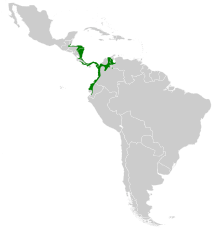Band-tailed barbthroat
The band-tailed barbthroat (Threnetes ruckeri) is a medium-sized hummingbird which is a resident breeder from southeastern Guatemala and Belize to western Ecuador and western Venezuela.[1]
| Band-tailed barbthroat | |
|---|---|
.jpg) | |
| Scientific classification | |
| Kingdom: | Animalia |
| Phylum: | Chordata |
| Class: | Aves |
| Order: | Apodiformes |
| Family: | Trochilidae |
| Genus: | Threnetes |
| Species: | T. ruckeri |
| Binomial name | |
| Threnetes ruckeri (Bourcier, 1847) | |
| Subspecies[2] | |
|
T. r. ruckeri (Bourcier, 1847) | |
 | |
This hermit species inhabits the understory of wet forests, woodland edges and old second growth. It occurs in the lowlands, typically up to an elevation of 800 m, although young birds may wander higher.
The nest is a cup of plant fibres attached 2–4 m high on the underside of a Heliconia or sometimes a banana leaf. The female alone incubates the two white eggs.
The band-tailed barbthroat is 10.2–11 cm long and weighs 5–5.8 g. it has a long decurved bill, and, as with other hermit hummingbirds, the sexes are similar. The adult has bronze-green upperparts, a dark ear patch and dusky malar stripe. The chest is rusty-orange and the underparts are otherwise grey. Young birds resemble the adult, but have buff feather tips.
The southern subspecies T. r. venezuelensis is somewhat duller on the breast than the nominate northern race.
The band-tailed barbthroat has a high thin tseep call, and the male's song, given alone or at a lek, is a didiDIT dew dew in the Caribbean lowlands, but on the Pacific side the song is longer and includes trills and warbles.
Like other hermits, this barbthroat visits widely separated flowers including: Heliconia, Costus, and bananas, and the male is less aggressively territorial than other male hummingbirds.
References
- BirdLife International (2012). "Threnetes ruckeri". IUCN Red List of Threatened Species. 2012. Retrieved 26 November 2013.CS1 maint: ref=harv (link)
- "Threnetes ruckeri". Integrated Taxonomic Information System. Retrieved 5 April 2011.
- Hilty, Birds of Venezuela, ISBN 0-7136-6418-5
- Stiles and Skutch, A guide to the birds of Costa Rica ISBN 0-8014-9600-4
External links
- Band-tailed Barbthroat photo; Article w/RangeMaps Infonatura NatureServe
